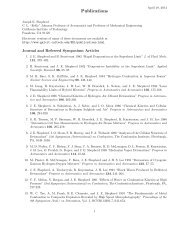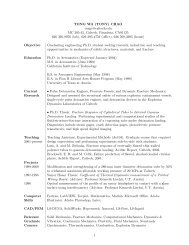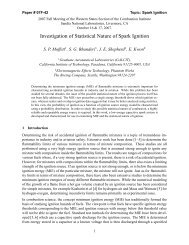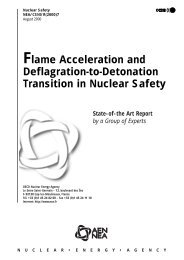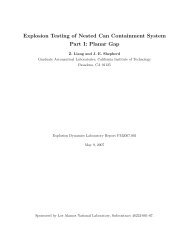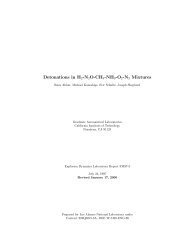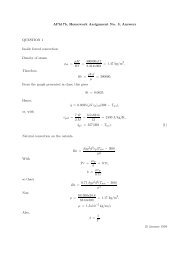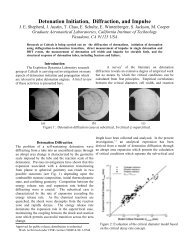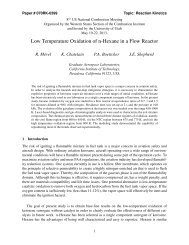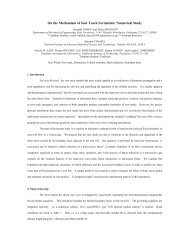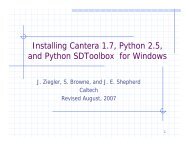Thermodynamic Cycle Analysis for Propagating Detonations
Thermodynamic Cycle Analysis for Propagating Detonations
Thermodynamic Cycle Analysis for Propagating Detonations
You also want an ePaper? Increase the reach of your titles
YUMPU automatically turns print PDFs into web optimized ePapers that Google loves.
this detailed energy balance and the thermodynamic system approach demonstrates theself-consistency of our <strong>for</strong>mulation of the FJ detonation cycle.Thermal efficiencyThe FJ cycle can be used to define an upper bound on the efficiency of devices using apropagating detonation as the combustion step. The thermal efficiency <strong>for</strong> the conversion ofchemical energy into mechanical work is the ratio of the net work done to the specific heatof combustion of the mixture. From the previous discussion, <strong>for</strong> FJ cycle this isη th = w netq c= h 1 − h 5q c. (1)The specific heat of combustion q c is computed as the enthalpy difference between the reactantsand the products at initial pressure and temperature: q c = h 1 − h 6 .We first investigate the values of the thermal efficiency <strong>for</strong> a perfect gas model by representingthe detonation process using the one-γ model of detonation, 14 which relates the CJMach number to the specific heat of combustion.M CJ = √ H + 1 + √ H where H = (γ2 − 1)q c2γRT 2(2)[η th = 1 − C pT 1q c1M 2 CJ( ) γ+1 ]1 + γM2 γ CJ− 11 + γThe thermal efficiency is represented in Fig. 3 as a function of the CJ Mach number <strong>for</strong>two values of the specific heat ratio γ representative of the products of fuel-oxygen and fuelairdetonations. The thermal efficiency increases with increasing CJ Mach number, whichincreases 14 with the specific heat of combustion q c . A higher heat of combustion increases thepressure ratio through the detonation wave significantly more than the temperature ratio.This means that the detonation products undergo a stronger expansion between states 4 and5, which reduces the temperature at state 5. Thus, less heat is rejected during process 5–1and the efficiency is higher. Figure 3 also shows that the variation of the thermal efficiencydepends strongly on the value chosen <strong>for</strong> γ. At constant CJ Mach number, a lower valueof γ in the detonation products yields a lower efficiency. The parameter γ − 1 controls theslope of the isentrope 4–5 in the pressure-temperature plane. Although the pressure ratioP 4 /P 5 varies with γ, the main effect of decreasing γ is to increase the temperature at state5 so that more heat is rejected during process 5–1. The result of Eq. 3 is identical to theresult obtained by Heiser and Pratt, 3 who computed the thermal efficiency by calculatingthe entropy increments associated with each process in the detonation cycle. However, the(3)4 of 14



